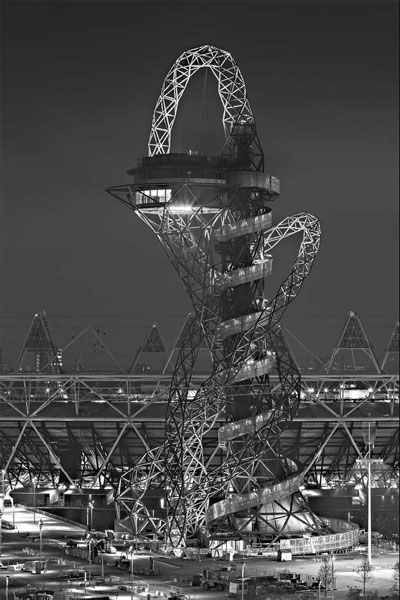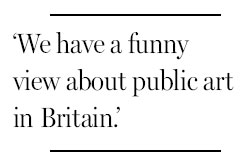Towering sculpture draws ire of British
 |
|
The ArcelorMittal Orbit, lighting up the night (and more than a few tempers) at the Olympic Park in East London. Some Londoners have described it as a "contorted mass of entrails." Arcelormittal |
LONDON - Boris Johnson, the mayor of London, has said that the ArcelorMittal Orbit, a spiraling goliath of red tangled steel that stands 35 stories above the city's Olympic Park, would have "dwarfed" the aspirations of Gustave Eiffel and "boggled the minds" of ancient Romans.
Many Londoners don't see it quite that way. They've called the Orbit, designed by the Indian-born sculptor Anish Kapoor and the Sri Lankan architect Cecil Balmond, the "Eye-full Tower" and "Helter-Skelter," and have compared it to a "contorted mass of entrails."
Envisioned as a symbol of London looming over the site of this summer's Olympic Games, the Orbit, which visitors will ascend and explore, is designed as an attraction to rival the London Eye and Big Ben. But for now, the sculpture is also a prime target for British Olympic crankiness.
"The most lasting legacy of the multimillion-pound circus about to roll into town will be a big red clot on the landscape," the columnist Catherine Cain wrote of the Orbit in The Watford Observer.
The Orbit, about 20 meters higher than the 93-meter-tall Statue of Liberty, has drawn criticism not just for its avant-garde design, but as a symbol - in spite of its mostly private financing - of the billions in government money being spent on the Olympics at a time when Britons are struggling under austerity measures.
"We have a funny view about public art in Britain - it's seen as slightly odd and elitist," said John Simpson, an architect at Ushida Findlay, a London firm that helped transform the sculpture into a structurally sound, functional building. (The Orbit has had a more favorable reception among art and architecture critics.)
That the tower, which will open with the start of the games on July 27, will have an admission price of $23, on top of the $15 entrance fee to the park, only adds to the perception of excess and elitism. Mr. Kapoor called the Orbit's entry fee "a lot of money for a lot of people" and said after the Olympics he'd like a price that matched his vision of a "democratic monument open to all."

David Cameron, the prime minister of Britain, has promoted the city's post-Olympic plans to develop the derelict district of Stratford into a mixed-use development, with the Orbit as a focal point. "I think it's time to tear up any notion of the Olympics' leaving behind white elephants," Mr. Cameron said in a news conference.
But 51 percent of British residents surveyed in March said they disagreed with Mr. Cameron's statements that the Olympic Games would be well worth the cost to taxpayers. Government officials said the price tag has risen to $17.2 billion, driven largely by the cost of security.
The Orbit project got its start in 2009 after Mayor Johnson ran into Lakshmi N. Mittal, the Indian chief executive of the huge steel maker ArcelorMittal and one of the world's richest men, at the World Economic Forum in Davos, Switzerland. The mayor pitched Mr. Mittal the idea of building something to add artistic panache to the Olympic Park. Mr. Mittal contributed ��19.6 million ($31.4 million), almost the entire budget of the project, to have the sculpture named after his company.
Nearly 60 percent of the more than 2,000 tons of steel used to make the Orbit came from recycled scrap. The materials were procured from every continent in which ArcelorMittal operates and were assembled in a factory near Manchester.
"The U.K. didn't have the money that the Chinese had for Beijing," said Ian Louden, head of brand worldwide for ArcelorMittal. He added that the company saw the structure as a chance to spread brand awareness.
In 2010 Mr. Kapoor and Mr. Balmond, who then worked for the engineering and design firm Arup (best known for its work on the Centre Pompidou in Paris, the Sydney Opera House and the "Bird's Nest" Olympic stadium in Beijing), won an open competition to design something that would add pizazz to the mostly white stadiums and buildings that make up the Olympic Park.
They found inspiration in the Tower of Babel and Tatlin's Tower, a helix-shaped mass of iron, glass and steel designed by the Russian artist and architect Vladimir Tatlin, but never built. "We thought London needed a high-energy something," Mr. Balmond said. "We thought this idea represents flux, change, and London is full of change, with various ethnic streams."
Mr. Kapoor said he wanted the Orbit to be a collective, interactive experience. Visitors walk under a rust-colored, cone-shaped canopy entrance to elevators with viewing portals that carry them up to a two-story observation deck.
After the completion of the tower in May, Mr. Mittal donated it to the London Legacy Development Corporation, which will be responsible for transforming the Olympic Park into a housing development, complete with parks, retail space and a transformed aquatics center, after the Games.
After the Olympics, the Orbit will serve as the centerpiece of a public pavilion with the capacity to host corporate events, gallery exhibitions and as many as up one million visitors annually.
After a friend described the Orbit as an eyesore, a Londoner, Benjamin Tucker, noted in a Twitter message that "it would take an awful lot to blight East London. Stratford's a dump!"
The New York Times
















